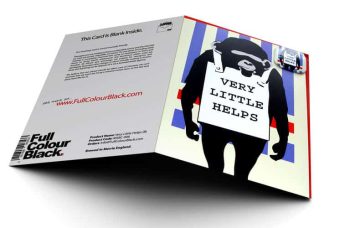
Installation of Marc Horowitz paintings at the Johannes Vogt Gallery. Image courtesy of the gallery.
Sophisticated Play
Marc Horowitz, “Nothing on the Other Side of the Slash,” March 30. Vogt Gallery, 958 Madison Ave, Manhattan
With the release of a child, Horowitz not only blitzes and blisses out the eye, but evokes the subversive implications of living out our desires.
Marc Horowitz’s latest paintings are all variations on the same composition: stark backgrounds resonate like a crisp sky, as chunky stick figures pulse like balloons. As in Rothko’s chapel, or Rembrandt’s self-portraits, Horowitz repeats and alters the same idea in a series. And, as Rothko reduced his palette to shades of black, focusing on rectangular forms, and Rembrandt to shades of brown, focusing on the self-portrait, Horowitz’s latest interest can be compared to these exalted masters: his works, as packed with juicy color as ever before, have discarded earlier structures and devices (inkjet prints which allowed for complex puns on rendered horses, landscapes, etc.) in favor of an undeniably primal composition.
Paint Alchemy
Horowitz describes this progression from the point of view of the past, and especially the use of pastiche, as a “hazing.” Earlier work can be sought after, or skill, but abandoning these supports he soars. The solar radiation is related to the crude stick figure.
The experience the artist had while making these recent paintings is that of total intense fervor and excitement. Horowitz describes the moments when, in a high-wire-act, he pushes and pulls, dashed and drove the heavy, mushy, vibrating oil sticks over the minimalistic background. Other marks, using the brush, were loaded with an alchemist’s mixture: pigment mixed with oils, varnishes and other esoteric mediums, which were whipped to a certain perfection.
The combination of heady technical skill and the ability to let yourself go completely Horowitz walks. The artist is in a process of dualism in his personality: one being sophisticated intention and the other, a motive of instinctual play.

Artistic Development
Horowitz’s earliest works involved performance and social interaction – especially with new media. He existed in the strange space between comedian, prankster, entertainer, artist and philosopher. For example, in 2004, national media picked up an impromptu project in which the young artist wrote, “dinner w / marc” with a product in which it was printed in a Crate and Barrel catalog. As a result, he took a trip to America where he broke up.
In 2010, Horowitz embarked on the “Advice of Strangers” project: hearings voted on his daily decision making and watched the results. This included the intimacy of his therapy, where strangers voted if he should talk about his “mother,” “boundaries,” or “work.”
Because of the personal conflicts caused by such experiments, this was the beginning of the end for Horowitz’s clowning, brilliant interruption of the normalcy of daily life, and exploration of internet culture. Horowitz often describes his subsequent painting practice as a move “inwards.” He has taken his knack for humorous subversion, but his work has become more introverted.
Importantly, Horowitz has retained his comedic personality, but without the dramatic entanglements of the outer world – both in business entertainment, but also in the basic interpersonal necessity of performance-based creativity.
Desire and Play
The ability to be aesthetic expresses his inner playfulness is reminiscent of certain philosophical notions in the work of Gilles Deleuze and Carl Jung. Both thinkers are in favor of their essential desire. It is through the creative exploration of the unconscious is accessed, rather than unleashed to hedonistic detriment. In Horowitz’s paintings, there is the tangible sense of an artist who lets his most child-like passion for creativity express itself.
It is this basic willingness to live out the instinct of play that defies a broadly felt restrictiveness that appears as drudgery and nihilism in the modern world. Horowitz has always defied the fundamental aspects of our social, economic and political influences through this basic value.
Whether it is an irony that struggles against some infective meaninglessness, or even a tendency towards humor and absurdity, or even for the sheer hell of it, Horowitz has made a life of his quirky, idiosyncratic thoughts and desires.
According to Deleuze, it is the energetic tap of our desire that creates new paradigms. For Jung, the connection with a playful inner child is the key to reorienting individuals and society, revitalizing their souls, which are starving in a materialistic, capitalistic world. When they are in this world, their vitality flows out into the coexistent world (think Deleuze’s “plane of immanence,” or Jung’s “collective unconscious”).
Marc Horowitz embodies this freedom in his painting practice, and when we take in his paintings, we glimpse that potential within ourselves.





